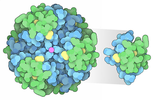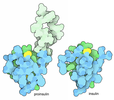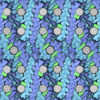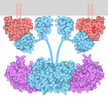[English] 日本語
 Yorodumi
Yorodumi- PDB-9dn6: Insulin receptor bound with de novo designed agonist called "RF-405". -
+ Open data
Open data
- Basic information
Basic information
| Entry | Database: PDB / ID: 9dn6 | |||||||||||||||||||||
|---|---|---|---|---|---|---|---|---|---|---|---|---|---|---|---|---|---|---|---|---|---|---|
| Title | Insulin receptor bound with de novo designed agonist called "RF-405". | |||||||||||||||||||||
 Components Components |
| |||||||||||||||||||||
 Keywords Keywords | SIGNALING PROTEIN / Insulin receptor / de novo designed agonist | |||||||||||||||||||||
| Function / homology |  Function and homology information Function and homology informationregulation of female gonad development / positive regulation of meiotic cell cycle / insulin-like growth factor II binding / positive regulation of developmental growth / male sex determination / insulin receptor complex / insulin-like growth factor I binding / positive regulation of protein-containing complex disassembly / insulin receptor activity / exocrine pancreas development ...regulation of female gonad development / positive regulation of meiotic cell cycle / insulin-like growth factor II binding / positive regulation of developmental growth / male sex determination / insulin receptor complex / insulin-like growth factor I binding / positive regulation of protein-containing complex disassembly / insulin receptor activity / exocrine pancreas development / dendritic spine maintenance / cargo receptor activity / insulin binding / adrenal gland development / PTB domain binding / neuronal cell body membrane / Signaling by Insulin receptor / IRS activation / positive regulation of respiratory burst / amyloid-beta clearance / positive regulation of receptor internalization / regulation of embryonic development / insulin receptor substrate binding / epidermis development / protein kinase activator activity / positive regulation of glycogen biosynthetic process / Signal attenuation / heart morphogenesis / transport across blood-brain barrier / phosphatidylinositol 3-kinase binding / Insulin receptor recycling / insulin-like growth factor receptor binding / dendrite membrane / neuron projection maintenance / positive regulation of mitotic nuclear division / receptor-mediated endocytosis / Insulin receptor signalling cascade / positive regulation of glycolytic process / positive regulation of D-glucose import / learning / receptor protein-tyrosine kinase / caveola / cellular response to growth factor stimulus / receptor internalization / memory / male gonad development / cellular response to insulin stimulus / positive regulation of nitric oxide biosynthetic process / insulin receptor signaling pathway / late endosome / glucose homeostasis / amyloid-beta binding / protein autophosphorylation / PI5P, PP2A and IER3 Regulate PI3K/AKT Signaling / protein tyrosine kinase activity / lysosome / positive regulation of canonical NF-kappaB signal transduction / positive regulation of phosphatidylinositol 3-kinase/protein kinase B signal transduction / receptor complex / positive regulation of MAPK cascade / endosome membrane / positive regulation of cell migration / G protein-coupled receptor signaling pathway / protein domain specific binding / axon / external side of plasma membrane / positive regulation of cell population proliferation / regulation of DNA-templated transcription / symbiont entry into host cell / positive regulation of DNA-templated transcription / GTP binding / protein-containing complex binding / extracellular exosome / ATP binding / identical protein binding / membrane / plasma membrane Similarity search - Function | |||||||||||||||||||||
| Biological species | synthetic construct (others) Homo sapiens (human) Homo sapiens (human) | |||||||||||||||||||||
| Method | ELECTRON MICROSCOPY / single particle reconstruction / cryo EM / Resolution: 4 Å | |||||||||||||||||||||
 Authors Authors | Bai, X.C. | |||||||||||||||||||||
| Funding support |  United States, 1items United States, 1items
| |||||||||||||||||||||
 Citation Citation |  Journal: Mol Cell / Year: 2025 Journal: Mol Cell / Year: 2025Title: Tuning insulin receptor signaling using de novo-designed agonists. Authors: Xinru Wang / Sarah Cardoso / Kai Cai / Preetham Venkatesh / Albert Hung / Michelle Ng / Catherine Hall / Brian Coventry / David S Lee / Rishabh Chowhan / Stacey Gerben / Jie Li / Weidong An ...Authors: Xinru Wang / Sarah Cardoso / Kai Cai / Preetham Venkatesh / Albert Hung / Michelle Ng / Catherine Hall / Brian Coventry / David S Lee / Rishabh Chowhan / Stacey Gerben / Jie Li / Weidong An / Mara Hon / Michael Gao / Ya-Cheng Liao / Domenico Accili / Eunhee Choi / Xiao-Chen Bai / David Baker /  Abstract: Insulin binding induces conformational changes in the insulin receptor (IR) that activate the intracellular kinase domain and the protein kinase B (AKT) and mitogen-activated protein kinase (MAPK) ...Insulin binding induces conformational changes in the insulin receptor (IR) that activate the intracellular kinase domain and the protein kinase B (AKT) and mitogen-activated protein kinase (MAPK) pathways, regulating metabolism and proliferation. We reasoned that designed agonists inducing different IR conformational changes might induce different downstream responses. We used de novo protein design to generate binders for individual IR extracellular domains and fused them in different orientations with different conformational flexibility. We obtained a series of synthetic IR agonists that elicit a wide range of receptor autophosphorylation, MAPK activation, trafficking, and proliferation responses. We identified designs more potent than insulin, causing longer-lasting glucose lowering in vivo and retaining activity on disease-causing IR mutants, while largely avoiding the cancer cell proliferation induced by insulin. Our findings shed light on how changes in IR conformation and dynamics translate into downstream signaling, and with further development, our synthetic agonists could have therapeutic utility for metabolic and proliferative diseases. | |||||||||||||||||||||
| History |
|
- Structure visualization
Structure visualization
| Structure viewer | Molecule:  Molmil Molmil Jmol/JSmol Jmol/JSmol |
|---|
- Downloads & links
Downloads & links
- Download
Download
| PDBx/mmCIF format |  9dn6.cif.gz 9dn6.cif.gz | 700.1 KB | Display |  PDBx/mmCIF format PDBx/mmCIF format |
|---|---|---|---|---|
| PDB format |  pdb9dn6.ent.gz pdb9dn6.ent.gz | 560 KB | Display |  PDB format PDB format |
| PDBx/mmJSON format |  9dn6.json.gz 9dn6.json.gz | Tree view |  PDBx/mmJSON format PDBx/mmJSON format | |
| Others |  Other downloads Other downloads |
-Validation report
| Summary document |  9dn6_validation.pdf.gz 9dn6_validation.pdf.gz | 1.2 MB | Display |  wwPDB validaton report wwPDB validaton report |
|---|---|---|---|---|
| Full document |  9dn6_full_validation.pdf.gz 9dn6_full_validation.pdf.gz | 1.2 MB | Display | |
| Data in XML |  9dn6_validation.xml.gz 9dn6_validation.xml.gz | 58.4 KB | Display | |
| Data in CIF |  9dn6_validation.cif.gz 9dn6_validation.cif.gz | 87.7 KB | Display | |
| Arichive directory |  https://data.pdbj.org/pub/pdb/validation_reports/dn/9dn6 https://data.pdbj.org/pub/pdb/validation_reports/dn/9dn6 ftp://data.pdbj.org/pub/pdb/validation_reports/dn/9dn6 ftp://data.pdbj.org/pub/pdb/validation_reports/dn/9dn6 | HTTPS FTP |
-Related structure data
| Related structure data |  47031MC  9dniC  9dnnC M: map data used to model this data C: citing same article ( |
|---|---|
| Similar structure data | Similarity search - Function & homology  F&H Search F&H Search |
- Links
Links
- Assembly
Assembly
| Deposited unit | 
|
|---|---|
| 1 |
|
- Components
Components
| #1: Protein | Mass: 15288.688 Da / Num. of mol.: 2 Source method: isolated from a genetically manipulated source Source: (gene. exp.) synthetic construct (others) / Production host:  #2: Protein | Mass: 155329.094 Da / Num. of mol.: 2 Source method: isolated from a genetically manipulated source Source: (gene. exp.)  Homo sapiens (human) / Gene: INSR / Production host: Homo sapiens (human) / Gene: INSR / Production host:  Homo sapiens (human) Homo sapiens (human)References: UniProt: P06213, receptor protein-tyrosine kinase Has protein modification | Y | |
|---|
-Experimental details
-Experiment
| Experiment | Method: ELECTRON MICROSCOPY |
|---|---|
| EM experiment | Aggregation state: PARTICLE / 3D reconstruction method: single particle reconstruction |
- Sample preparation
Sample preparation
| Component | Name: Insulin receptor bound with de novo designed agonist RF-405 Type: COMPLEX / Entity ID: all / Source: RECOMBINANT |
|---|---|
| Molecular weight | Value: 0.4 MDa / Experimental value: YES |
| Source (natural) | Organism:  Homo sapiens (human) Homo sapiens (human) |
| Source (recombinant) | Organism:  Homo sapiens (human) Homo sapiens (human) |
| Buffer solution | pH: 7.4 |
| Specimen | Embedding applied: NO / Shadowing applied: NO / Staining applied: NO / Vitrification applied: YES |
| Specimen support | Grid material: GOLD / Grid mesh size: 300 divisions/in. / Grid type: Quantifoil |
| Vitrification | Cryogen name: ETHANE |
- Electron microscopy imaging
Electron microscopy imaging
| Experimental equipment |  Model: Titan Krios / Image courtesy: FEI Company |
|---|---|
| Microscopy | Model: TFS KRIOS |
| Electron gun | Electron source:  FIELD EMISSION GUN / Accelerating voltage: 300 kV / Illumination mode: FLOOD BEAM FIELD EMISSION GUN / Accelerating voltage: 300 kV / Illumination mode: FLOOD BEAM |
| Electron lens | Mode: BRIGHT FIELD / Nominal defocus max: 2200 nm / Nominal defocus min: 1200 nm / Alignment procedure: COMA FREE |
| Specimen holder | Cryogen: NITROGEN / Specimen holder model: FEI TITAN KRIOS AUTOGRID HOLDER |
| Image recording | Electron dose: 60 e/Å2 / Film or detector model: GATAN K3 BIOQUANTUM (6k x 4k) |
| EM imaging optics | Energyfilter name: GIF Bioquantum / Energyfilter slit width: 20 eV |
- Processing
Processing
| EM software |
| ||||||||||||||||||||||||||||||
|---|---|---|---|---|---|---|---|---|---|---|---|---|---|---|---|---|---|---|---|---|---|---|---|---|---|---|---|---|---|---|---|
| CTF correction | Type: PHASE FLIPPING AND AMPLITUDE CORRECTION | ||||||||||||||||||||||||||||||
| Symmetry | Point symmetry: C2 (2 fold cyclic) | ||||||||||||||||||||||||||||||
| 3D reconstruction | Resolution: 4 Å / Resolution method: FSC 0.143 CUT-OFF / Num. of particles: 66409 / Symmetry type: POINT |
 Movie
Movie Controller
Controller




 PDBj
PDBj











